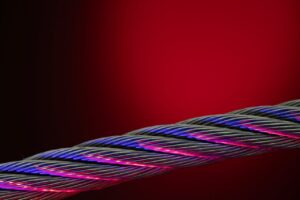Fibre Optic Meaning: How Light Transmits Data
Modern communications rely on moving ever-greater volumes of data more quickly and reliably. Fibre optic technology makes that possible by sending information as pulses of light rather than electrical current. Here’s a straightforward look at what fibre optics are, how they work, and why they outperform traditional copper wires for everything from home broadband to emergency services links.
What Is a Fibre Optic Cable?
At its core, a fibre optic cable consists of one or more very thin strands of glass or plastic often thinner than a human hair bundled inside a protective jacket. Each strand, or optical fibre, carries pulses of light. Because light travels faster and with less resistance than electrical signals, these cables can move huge amounts of data over very long distances with minimal loss. Hundreds or even thousands of these fibres grouped together create a single cable that forms the backbone of modern networks.
How Light Stays Inside the Fibre
Optical fibres guide light by using total internal reflection. When you shine a beam of light into one end of the fibre at a shallow angle, the light bounces off the inner walls of the glass or plastic core repeatedly without escaping. This trapping of light lets the pulses travel hundreds of kilometres with only a small drop in strength. The result is data transmission that remains clear and strong far beyond the reach of copper.
Light Pulses vs. Electrical Signals
Traditional copper cables send data as electrical pulses. Over distance, these signals weaken and must be boosted by repeaters every few kilometres. Even then, electrical noise and interference from nearby machinery or radio transmitters can corrupt the data. Fibre optics avoid these issues entirely by keeping the information in the form of light signals. No repeaters are needed as often, and electromagnetic interference has virtually no effect on the glass or plastic strands.
Why Fibre Optics Offer Higher Bandwidth
Bandwidth measures how much data you can send through a cable at one time. Since light waves operate at frequencies millions of times higher than electrical signals, optical fibres can carry far greater bandwidths. There are two main fibre types in use:
• Single-Mode Fibres feature a tiny core that guides a single beam of light. These fibres support very long-distance links, such as undersea cables connecting continents.
• Multimode Fibres have a larger core allowing multiple light rays to travel side by side. They work well for shorter runs inside buildings, campus networks, or data centres where ultra-long reach isn’t required.
Both types far outstrip copper’s capacity, making fibre optics the clear choice for high-speed, high-volume data transmission.

Building Modern Broadband Networks
In many urban and suburban areas, a hybrid approach still exists: fibre cables run to street cabinets or distribution points, then copper lines carry the data the rest of the way to homes and businesses. This “fibre to the cabinet” setup improved speed over older ADSL lines but still bowed to copper’s limits. Fibre-to-the-premises, or full fibre, bypasses copper entirely, bringing glass or plastic cables directly into each property. Plugging a preconfigured fibre router into the outlet delivers the fastest possible broadband connection with symmetric download and upload speeds.
Benefits for Everyday Users
Whether you’re streaming 4K movies, gaming online, hosting video conferences, or backing up large files to the cloud, full fibre broadband makes a noticeable difference. You experience near-instant load times, smooth high-definition streams, and crystal-clear calls. Full fibre’s stable performance means no unexpected buffering or slowdowns, even when the whole street is online at once. For families with multiple devices or home offices supporting remote work this reliability becomes essential.
Critical Role in Emergency Services
Fast and dependable data links are vital for emergency responders. Paramedics send patient vitals to hospitals as they travel, fire services monitor live video feeds from incident scenes, and police use real-time digital maps and body cam footage. Fibre optics’ resistance to electrical surges, weather disruptions, and heavy traffic ensures these services can communicate without interruption. In life-or-death situations, the clarity and low latency of fibre can literally save lives.
Reducing Signal Loss Over Long Distances
Copper cables suffer significant signal degradation over distance, requiring amplifiers and repeaters. Fibre optics’ light-based approach sees far less attenuation. Undersea fibre cables routinely span thousands of kilometres, linking continents with only a handful of power-boost stations. This low signal loss makes fibre the only practical medium for global internet backbones, international phone calls, and high-speed data links between major cities.

Immunity to Electromagnetic Interference
Unlike copper, which can act like an unwanted antenna, optical fibres remain unaffected by nearby electrical fields, radio transmitters, or lightning strikes. That immunity makes fibre optics ideal for installations near heavy machinery, rail lines, or power substations where interference could cripple copper networks. The result is a consistently clean signal that keeps data flowing smoothly in the harshest conditions.
Advances in Fibre Technology
Research teams worldwide continue to push fibre’s limits. Hollow-core fibres guide light through a tiny air-filled channel to reduce latency further. Photonic-crystal fibres manipulate light in novel patterns for even higher bandwidth. New glass compositions and manufacturing techniques promise lower costs and broader deployments, bringing full fibre connections to more homes and businesses every year.
Why Fibre Optics Matter Today and Tomorrow
Fibre optic cables have become the backbone of global communications. They support everything from high-definition streaming and cloud computing to telemedicine and autonomous vehicles. As data demands grow, only fibre can deliver the speed, volume, and reliability required. Whether single-mode or multimode, glass or plastic, optical fibres remain the gold standard for data transmission over long distances.
Making the Switch to Full Fibre Broadband
At Rocket Fibre, we deliver pure fibre-to-the-premises connections with symmetric speeds, no data caps, and 24/7 UK-based support. Our Fibre 300, Fibre 500, and Gigabit plans suit every need from casual browsing to mission-critical operations. Visit rocket-fibre.co.uk to check your postcode, compare packages, and book your full fibre installation. Experience the power and dependability of light-based data transmission in your home or business today.








